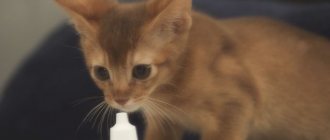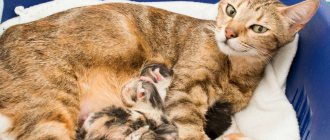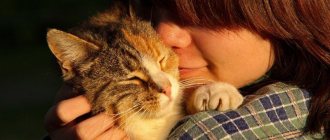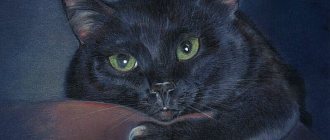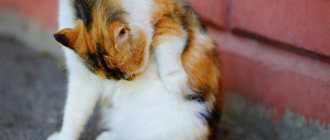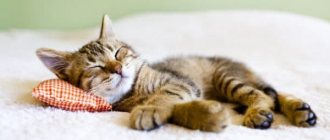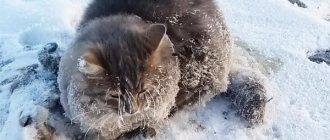When we get pets, particularly cats, we must remember that health is a very important aspect. A living creature requires attention and care. And how you care for your cat will determine its vital activity. It's good when the cat is energetic, has an excellent appetite and there are no signs that something is wrong with it. But if you suddenly notice that your pet has begun to behave differently, something is bothering her, she has become less active, and is not eating well, then this means that not everything is in order with her health and something needs to be done. The first thing is to observe how often the cat begins to go to the toilet in small ways. Perhaps this is the essence of such changes in her behavior.
Healthy cat
Frequent visits to the litter box may be a warning sign that your pet is sick. It is considered normal if a cat goes to the toilet 2-3 times a day. This should be quite enough for her. At the same time, the process of urination does not cause her any discomfort. Urine is light yellow or orange in color and does not have a pungent or unpleasant odor. The most innocuous reason for a cat to pee frequently is that it is drinking large amounts of water, perhaps because it is hot or because it has eaten salty food. Old age may also be the cause of frequent urge to go to the toilet. With age, muscles weaken and urine retention becomes weaker. In these cases, there is no reason for great excitement.
Diagnostics
To establish the causes of pollakiuria, anamnesis is collected, clinical symptoms are considered, and laboratory tests of urine and blood are performed. An important diagnostic test is a change in the visual parameters of urine - transparency, color, presence of sediment, unpleasant odor. Pay attention to the frequency of trips to the litter box and the amount of excrement. It is important to monitor your water consumption. Thirst in the heat is a normal phenomenon, accompanied by an increase in small trips. If a cat drinks a lot under comfortable environmental conditions, diabetes is suspected.
The cat pees often
But what if the reason is not in drinking a large amount of liquid or in old age? Then why does the cat pee often? Perhaps something is bothering her, and in this way she is trying to draw attention to herself and what hurts her. Don't punish her. Show understanding and increased care towards it, because the animal cannot say what exactly is bothering it, and is not able to help itself. First, watch your cat closely. If her general condition does not indicate that she may be sick with something, then the reason must be sought in her psychology. But if you notice that your pet has become lethargic and weak, its urine has an unpleasant odor, it contains purulent or bloody discharge, it becomes dark or cloudy in color, if you notice that the process of urination causes pain, then it’s time to sound the alarm - your cat is seriously ill. In this case, the sooner you determine what’s wrong with your pet and begin treatment, the better for his health and life.
Reasons for visiting the litter box multiple times
If a pet begins to pee too often and little by little, this should immediately alert the owner. We can only hope that the reason for this phenomenon is the most harmless - your cat or cat in a state of hunting is simply marking the territory entrusted to them. However, not only adults, but also growing kittens can mark territory.
Unfortunately, there may be other, very unpleasant reasons for this behavior, which you should try to identify and analyze as soon as possible. For example, repeated trips to the litter box can occur if the cat begins to drink more - it seems to be a completely harmless factor, but such sudden thirst can also signal dangerous diseases, including diabetes.
Some of the main causes of frequent urination in cats include the following:
- enuresis;
- cystitis;
- urinary tract infections;
- urolithiasis disease;
- renal failure;
- stressful situations;
- diabetes;
- oncological and other neoplasms.
Frequent urination in itself is quite harmless, but there may be dangerous diseases behind it
Cats are very sensitive, and a variety of situations can put them into a stressful state, from moving to a new place and changing owners to the appearance of new pets or even pieces of furniture in the house. Having become overexcited, the animal begins to pee not only more often, but also past the tray - sometimes in the most unexpected places.
But if, after stress, the psychological and physical state of an animal can be completely restored within a few days, then the diagnosis and treatment of probable diseases will require much more time, effort and money.
Possible diseases
There are several diseases, a symptom of which may be that the cat pees very often and little. These are diseases of the genitourinary system. Some of them can be very insidious. What disease your cat has can be determined, of course, only by a veterinarian after examination and passing all the necessary tests. It is strongly not recommended to engage in treatment or give any medications on your own without a doctor’s prescription, without even knowing what happened to your cat. Your pet may only get worse and you will waste time.
Elimination of causes
If your pet has problems with urination, the veterinarian will prescribe special medications to eliminate the causes of the disease:
- diuretics;
- antispasmodics to relieve pain;
- antibiotics;
- sulfonamides to eliminate bacteria;
- antiparasitic drugs.
Note! When stress is the source of the problem, it is necessary to eliminate irritating factors. In some cases, the veterinarian will prescribe sedatives.
Pollakiuria, its causes and symptoms
So, your cat pees often, what should you do? Pollakiuria is frequent urination in animals. Psychological and physiological factors can influence its development. If we consider pollakiuria from the psychological point of view, then we, of course, must understand that cats, like people, are exposed to stress. Any change in the cat’s life that has become a serious stress for it can become an impetus for a behavioral disorder. This could be a change of place of residence, renovation, the birth of a child in the family in which she lives. Such changes are sometimes perceived negatively by the cat, and she, in turn, simply begins to take revenge by going to the toilet in the wrong places.
Let's look at the physiological reasons why a cat often pees. This may be kidney failure, which is characterized by bad breath, heavy breathing and very poor general condition of the animal. The next reason is diabetes. It smells like acetone. The cat has constant thirst, weakness, and deterioration in the condition of the coat. Another cause is kidney stones, in which it is very difficult for the animal to go to the toilet, and urine comes out with blood, and this is accompanied by vomiting, fever, and lethargy. If you miss the moment and do not start treatment on time, the animal may not survive.
Causes not related to illness
Diabetes mellitus in cats also causes increased urination. Veterinarians also identify causes that are not related to the disease.
With them, the cat does not require treatment. They are associated with temporary external influences or the physiological needs of the pet. The general condition of the cat rarely suffers.
Stressful situation
Stress occurs in cats just as it does in humans. The phenomenon can be triggered by moving, the appearance of another animal or a new person in the house. In addition to frequent visits to the litter box, stress is indicated by a change in the cat’s behavior and an increase or decrease in appetite.
During periods of stress, cats experience a drop in immunity, resulting in a risk of developing cystitis. Thus, stress, which usually goes away on its own, can provoke an inflammatory process that requires treatment.
Because of this, if, due to stress, the cat’s urination becomes not only frequent, but also mixed with blood, a visit to the veterinarian is required.
Be sure to read:
The cat cannot pee: causes, symptoms, what to do, first aid, treatment at home
Extreme thirst and drinking too much water
In the heat, the animal consumes a large amount of water, which leads to increased formation of urine and its frequent excretion. This process is natural and does not require treatment. As soon as the cat stops suffering from the heat and drinking excess water, frequent trips to the toilet will end.
If the air temperature is normal, and the pet suddenly starts drinking a lot of water, this is a sign of the development of pathology. When examined in such a situation, the cat may be diagnosed with diabetes, kidney pathologies, or cancerous tumors in the intestines. The necessary treatment will be determined by your veterinarian.
Territory designation
Cats and some cats mark their territory with urine. They splash on different surfaces while standing, raising their tail and shaking it. The urine has a special pungent odor. It is impossible to confuse this action with a regular trip to the toilet.
Cystitis
The most common and hard-to-treat disease in cats is cystitis, an inflammation of the mucous membrane of the bladder. This disease can be provoked by eating low-quality, cheap food, as well as various infections and the formation of kidney stones. It is also unsafe for owners to have close contact with sick animals, as there is a high risk of infection. Initially, the disease is almost impossible to recognize, only over time the symptoms become more obvious. Cystitis is divided into two types: acute and chronic. Chronic cystitis most often occurs in older cats. Acute develops into chronic, and if your cat is not treated in time, purulent processes may occur that can lead to peritonitis.
Conservative treatment
Therapeutic procedures are prescribed to restore urinary outflow and relieve the inflammatory process that causes urolithiasis in cats. Treatment should not only eliminate pain, but also be aimed at prevention, eliminating relapses and complications.
Obstruction most often occurs due to muscle spasm, which is caused by irritation and mechanical damage to the mucous membrane of the urinary ducts. The animal is prescribed a course of medication that eliminates stagnation of urine and restores the patency of the ureters. For this purpose, sedative medications and antispasmodics (baralgin, spasmolitin, atropine and others), as well as antibiotics and homeopathy (magnesia, cantharis, apis and others) are used. This stops an attack of urolithiasis in a cat and improves the patient’s condition. In combination with medications, lumbar novocaine blockade and heat are used.
Causes of this disease
Let's take a closer look at the causes of cystitis in cats, because there are many of them, and owners need to know them to prevent the disease:
- An unbalanced diet, overeating, feeding dry food, especially cheap food, contribute to the development of cystitis. The amount of salts in the urine increases, and the kidneys cannot cope with their function, the urethra becomes clogged.
- The animal is exposed to the cold for a long time.
- The presence of parasites such as ticks, fleas, and worms contributes to the rapid development of the disease.
- Stress.
- Viral and bacterial infections, which may be congenital.
- Exacerbation of pyelonephritis (kidney disease caused by bacteria) and urolithiasis.
Urinary standards
Owners rarely pay attention to the amount of urine excreted by their cat. Veterinarians say that on average cats go to the toilet 3-4 times a day. However, the volume of fluid removed depends entirely on a combination of factors:
- Pet's age. Babies up to three months of age can write 1-2 times a day. This is explained by the special nutrition of the kitten - the main food is mother's milk, it is almost completely digestible and does not contain harmful compounds that require excretion. Therefore, the kitten does not urinate as often - and this is normal. When switching to natural food and drink, the kitten’s body secretes liquid 3 times a day. A teenager walks small 5-6 times, and an adult walks 3-4 times.
- Gender. Due to the different structure of the genital organs, the frequency of urination is different: males pee more often than females.
- Exercise stress. An energetic pet drinks more than lazy fluffies, and therefore will pee more often. A sedentary animal can generally visit the toilet 1-2 times a day.
- The volume of liquid drunk. During the hot season, the pet drinks a lot of water and, accordingly, goes to the litter box more often.
On average, the amount of urine excreted in cats is 50-200 ml per day. This volume should be significantly less if the cat is fed dry industrial food. This type of nutrition forces him to drink 2-3 times more than the volume that cats consume when feeding natural food.
Treatment of cystitis
To make an accurate diagnosis, the animal is given an ultrasound and blood and urine samples are taken. Only after this the veterinarian prescribes treatment, which necessarily includes antispasmodics and antibacterial drugs. Cystitis is mainly treated with antibiotics. Also, in some cases, the veterinarian may prescribe washing the bladder with potassium permanganate or furatsilin. In parallel with this, it is necessary to take homeopathic and diuretic medications and do not forget about vitamins, which will also be useful for your pet. In especially severe and advanced cases, surgery has to be performed. Therefore, to prevent your cat from developing cystitis, pay close attention to her diet and, if possible, observe how often she runs to the litter box.
Treatment method and prognosis
There is no single treatment regimen for pollakiuria. Therapeutic procedures are prescribed after diagnosis. As mentioned above, pollakiuria can be a sign of a dangerous disease, so treatment will be aimed at eliminating it.
Thus, for diabetes mellitus, insulin therapy is an important stage of treatment. With the help of drip infusion of polyionic drugs, the water-salt balance is restored. The key to successful treatment and recovery or maintaining quality of life at a satisfactory level is nutritional correction and quality care.
It often happens that the pet will be limited in physical activity for the rest of its life, take appropriate medications and eat exclusively special medicinal food.
If pollakiuria is caused by stress, then, first of all, it is necessary to eliminate the source of psycho-emotional stress. To reduce the negative effects of stress, your veterinarian may prescribe anti-anxiety medications, such as Stop-Stress.
Cat marks are an unpleasant phenomenon, but an animal cannot be punished for it. The best way out would be castration or the sedative phytohormonal remedy Kot Bayun.
Antispasmodics are indicated to relieve pain; antibiotics and sulfa drugs are used to eliminate infections.
The prognosis for pollakiuria again depends on the underlying disease. If, for example, we are talking about an infection, then one course of antibiotic therapy is enough. But with malignant and benign diseases, veterinarians are no longer so optimistic in their forecasts.
Hematuria in cats
Why does a cat often pee in small amounts of blood? In this situation, your animal has hematuria. It is with this disease that urination is accompanied by bloody discharge. There can be many reasons for hematuria: injuries and blows to the genital organs, hypothermia, poisoning, worms, falls, reactions to some medications. The urine then becomes reddish, and in advanced forms of the disease, blood clots appear in it. Symptoms of the disease include vomiting blood, lethargy, and pain when trying to pee. As soon as you notice these signs, immediately take your animal to undergo all necessary tests (urine and blood tests, ultrasound, abdominal x-ray, vaginal smear, etc.) and to see a veterinarian.
Diagnosis of possible diseases
If you are concerned about any behavioral reactions of this kind, do not put off visiting your veterinarian for too long. In such cases, it is easy to lose time irrevocably, which will lead either to an advanced chronic illness or even to the death of your pet.
What to pay attention to
Pollakiuria is usually only the “first sign” in a series of large number of symptoms that should be paid close attention to. If visually one can only assume the presence of a disease, then it can be excluded or confirmed using modern diagnostic methods.
Be attentive to your pet - this will keep him healthy
Table: diseases that cause frequent urination
| Disease | Symptoms | Diagnostic methods |
| Enuresis |
|
|
| Cystitis |
|
|
| Urolithiasis disease |
|
|
| Tumors |
|
|
Attempts to make a diagnosis on your own, let alone prescribe treatment for your pet, can be disastrous for him - only an experienced veterinarian has the right to do this on the basis of an informative examination.
But for self-education, it will be useful to have an idea of what normal urine test parameters should be for a healthy cat.
A urine test can tell you a lot about your pet's health.
Table: deciphering the analysis of cat urine at the household level
| Index | Norm | Notes |
| Density | 1.020–1.035 | Density readings indicate how concentrated various substances dissolved in urine are and whether the kidneys are functioning normally |
| Color | Straw yellow |
|
| Transparency | Absolute | Must not be:
|
| Acid reaction | pH 6 - 7.5 | This indicator demonstrates the balance of acids and alkalis in the urine formula - slightly sour urine is considered normal for cats. Acidity may vary slightly with diet |
| Protein | Not higher than 0.3 g per 1 liter | High protein content is a warning sign of kidney pathology |
| Glucose | Must be missing | The presence of glucose in the urine most often indicates that the animal is developing diabetes mellitus. |
| Red blood cells | Must be missing | Red blood cells in a cat’s urine indicate the following diseases:
|
| Leukocytes | Must be missing | Leukocytes in a cat’s urine are an indicator of the following diseases:
|
| Bacteriuria | Not higher than 10 thousand units. bacteria in 1 ml of urine | Higher rates indicate infection of the animal with pathogenic microflora |
Veterinarian's verdict
The main task of a veterinarian is to exclude the most dangerous diseases, and once they are diagnosed, then immediately prescribe treatment. If the symptoms are unclear, but there is reason to suspect a disease, then after a visual examination the animal will be offered a standard set of studies:
- blood chemistry;
- general urine analysis;
- Ultrasound;
- X-ray;
- hormone analysis;
- analysis of acetone levels, acid-base balance;
- study of the ratio of urine and fluid intake.
X-ray shows the presence of stones in a cat, and at the same time the development of pleurisy
Based on the results of diagnostic procedures, the specialist will make his verdict, the timeliness and accuracy of which directly determines how successful the healing of the disease will be.
Treatment
If your cat frequently pees blood, do not treat it yourself. After examination and tests, the doctor will prescribe the necessary treatment for your pet. Usually it necessarily includes antibiotics, painkillers, vitamin K1, and when the body is dehydrated, glucose or saline is introduced. If stones need to be removed, then surgery is required. To prevent the occurrence of this disease, as with cystitis, you need to monitor your cat's diet. You should also not let her go outside to avoid contact with infected animals. Don't forget to give her deworming medicine regularly.
Risk group
Disturbances in the functioning of the genitourinary system are observed closer to old age, that is, after 8-10 years. It is believed that males more often suffer from kidney problems, and females more often suffer from cystitis and incontinence. This is true, but the cat may well get urolithiasis, and the cat may get cystitis.
Unvaccinated cats are at risk because their bodies are more vulnerable to viral and bacterial attacks. Annual vaccination significantly reduces the risk of any disease.
Some breeds are also susceptible to genitourinary problems: British, Scottish Fold, Persian and Siamese cats. This is explained by their anatomical features.
Do not forget that an obese animal is also at risk. Excess weight can trigger the development of diabetes and kidney disease.
Veterinarian advice
When treatment is completed and your pet’s illness is behind you, it is important to remember that if you do not follow the rules of caring for it, a relapse may occur, and the disease will begin to progress with renewed vigor. This is especially true for cystitis.
Veterinarians recommend following preventive measures to prevent these difficult-to-treat diseases. The main thing is to feed your pets with high-quality food and provide them with the healthiest nutrition possible. If you want your cat to be healthy and energetic, then under no circumstances should you feed her cheap food. It contains chemicals that have absolutely no beneficial properties, but can only cause harm and lead to the occurrence of such serious diseases that will be very difficult to cure later. Do not allow a cat who has had an illness to sleep in the cold and become hypothermic. You need to make sure your cat drinks enough clean water. Also, in order to avoid contracting various infections, veterinarians advise that their pets be vaccinated. And if your cat has been diagnosed with one of these diseases, then periodically, for insurance, show it to a specialist. After all, you see, it’s easier to adhere to these precautions than to endanger the health and life of your beloved animal.
Prevention
Preventive measures against the occurrence of diseases accompanied by pollakiuria are as follows:
- For drinking use filtered or bottled water.
- Prevent the development of obesity through active games and a balanced diet, mainly high-quality ready-made food.
- Protect your pet from hypothermia and drafts.
- Conduct regular preventive examinations.
Not all diseases accompanied by pathologies of the urinary system are completely curable. But, constant monitoring of the pet’s condition and compliance with preventive instructions allows you to receive satisfaction from communicating with your pet.
We invite you to join our Zen channel and group on VKontakte or Odnoklassniki, where new articles for pet owners are published.
Similar articles:
- My cat has a nosebleed - what should I do?
- Inflammation of the lower lip in a cat
- Clear nasal discharge in cats
